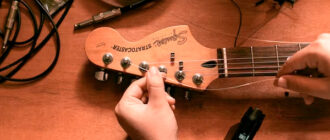It is important to know all the guitar strings when you play guitar. You have to know all the sounds, and all the notes if you really want to learn how to play guitar and how to play songs. But when you only start playing guitar, when you are a total beginner at playing guitar, you may have no idea what the strings are, and what the Low E is.
But do not worry, you will catch up on everything you should know.
And in this article, you will definitely know what the Low E string is and what it provides to you. Read the article carefully, and you will find the answers to your questions.

The guitar string notes: what you should know about it
Fortunately, before we go to learning what the Low E string is, we need to know what the guitar string notes are, in general, what they mean, and why you should know about the guitar string notes. Knowing these basics will help you to understand the guitar and the low E much better.
How many strings does a standard guitar have? There are six guitar strings. All standard guitars have only this string number. There are almost all standard guitars that are tuned the same, but there are also exceptions, the guitars that are tuned differently. It is important to remember.
You also need to know guitar string notes provided by the National Guitar Academy. It will help you play better and learn faster.
They are the basic strings. You can call them “open strings” even, but only when you play them or any of them on the fretboard. There is a difference in sound when you play open strings and when you do not play open strings.
The guitar strings: step-by-step
The first string is the E string, the high E string. This is the thinnest string.
The second string is the B string.
The third string is the G string.
The fourth string is the D string.
The fifth string is the A string.
And the sixth string, the final string, is the Low E. This string is the thickest, and this is the string we are looking for. The thickest strings have their own sound.

Why does it important to know the strings of the guitar?
When you only start playing guitar, when you only start learning how to do it, you may not know, why learning the guitar strings matters. Here you will learn why it is so.
As it said, all guitars can be tuned differently. When you learn the strings, the numbers, and the notes of one guitar, you will understand another guitar better if the sound will be different.
And good news for all the guitar players, the sixth string, which is the Low E string, never changes, it is almost the same on all the guitars.

Guitar string gauges in general
Guitar string gauges are something that you also definitely need to know for sure if you want to know how to improve your guitar play and how to make a sound that your guitar is producing better.
So, what is the guitar string gauge?
You need to know the guitar string gauge because it measures the High E string thickness (which is 1/1000th of an inch). The gauge may be different, it ranges from six to ten in size.
If you are playing an acoustic guitar, you definitely should choose a guitar that has a twelve gauge in size. It is recommended by many acoustic guitar players.
If you are playing electric guitars, you will find out, that the gauge is different here. You definitely should select a string gauge on this type of guitar, which ranges from nine or ten millimeters in size.

The Low E string: what you should know about it
As it said, the Low E is the thickest string, that a guitar has. You will find the string at the top of the neck of the guitar. As you can suggest, it is the low E note that the Low E is tuned.
You have to just tune this open string once to be able to play melodies and chords on your guitar.
The high E string and the Low E: the difference
You may not know that there is any difference since there is one ironic thing: the thickest string and the thinnest string are the same note, the E note if we are talking in terms of the musical scale.
But there is a difference between the thinnest string and the thickest string, between each open string. The sounds that they are producing are completely not the same.

Differences: step by step
You will easily hear the difference between these two strings. The regular E string is two whole octaves higher than the low E and the other strings.
You should play these two strings to hear the difference between each open string, and this will maintain your understanding of the strings and the guitar in general.
So, the positions of these two strings are different. The high E string is located at the bottommost, at the first place of the strings. It is also called the top string.
The Low E is located at the topmost, at the sixth place of the strings. It is also called the bottom string.
The vibration frequency of the strings is also different. The High E has a vibration frequency of 350 Hertz. The Low E has a vibration frequency of 82 Hertz.
Why does the difference in the vibration frequency matter? Because this difference defines that there is not the same pitch of the sound produced.
The strings have sounds that can be described. It is especially precious for beginners since it is important to have even a relatively vague understanding of the sounds of the strings.
So, the Low E string produces a sound, that is bass-filled and deep. The High E string produces a sound that reminds of a high pitch shrill sound.
If you want to play some chords, you can in theory play a couple of them and do not fret any notes at the same time. You can easily find several simple chords to play and to train yourself. And when you do it, you actually should fret the notes and the strings.
When you try to play for the first time, when you try to hear the difference between all 6 strings, you should just relax and keep things easy.
The progress may be slow, but it is still progress. Pay attention to the playing chords, they are very important since they are fundamental to music.

The E strings: a better sound if you play both?
Many players ask: if having both E strings helps to produce a better sound. Well, unfortunately, having both E strings does not help you necessarily to produce a sound that is better than you have made before.
The tuning of E strings themselves in general doesn’t influence the quality of a sound. It depends on something different.
The sound quality mostly depends on the quality of the guitar player, the quality of the strings, and the quality of the guitar itself.
What you should do is check out if your guitar and the strings are in order. And you should try to improve your guitar playing skills if you want to make a better sound. It doesn’t depend on having both E strings.

The E tuning: what is it?
Well, now you will learn about a well-known tuning, which is actually a standard guitar tuning. So, you have to know more about the standard tuning, and you have to get a full understanding of it.
E-tuning is a globally accepted standard tuning, so you will find something of it in very different places and among very different musicians.
This standard tuning is also a quite adopted method of tuning that is perfect for a standard electric guitar that has six strings.
The same is true about the acoustic guitar, in case you have exactly this type of guitar. The arrangement of this tuning is EADGBe, and it also has a single major third and intervals of fourths between all six strings.
As you can see and as you can guess, the EADG is the first four strings. Further, they are tuned almost the same as the upright bass could be tuned. It is true including the intervals of fourths between the strings, which we have already talked about.
You will find that there is an interval between the G string and the B string that is actually a major third. Now you have to take into account a fourth interval after the last one.
All of this in general will give you the E tuning, the EADGBe.
You probably have noticed that the guitar has four-step intervals.
Why is that so? It is so because it helps to reduce the tension that your hands may have. With that, you will play simple notes, chords, or scales without any effort, it would be easy.
And then, it is so because it helps to prevent a step gap that is between the E string and the F string. This step gap could have happened and sounded off when you are playing as an open string.

How to tune the E string?
When it is on the E string, you will notice that the fifth fret will and actually should produce the note that is the same as the open A string.
When it is on the fifth fret, you should put your finger on the guitar, on the E string. Then you should just play it, and you have to play it one to one.
You should rotate the tuning peg of the A string, it sounds higher. You have to rotate it to lower the pitch. Or, if this doesn’t work, try to rotate the tuning peg the other way. The main thing is that it has to be lower.

The E-string acoustic guitar: what should you know about it
The E-string acoustic guitar is a stringed instrument that has a special difference from many other guitars: to create a sound, it uses vibrating strings. The strings here are also different: they are strummed with a pick or fingers.
There, on an E-string guitar, you will find out that the High E string is measured depending on the size of the string. The string setup is very important in this matter.
Acoustic strings have a heavier action in comparison with electric strings. But the strings you are buying for your guitar will make a difference.
The difference is in the sounds, which, of course, also depends on your playing style and the tone you are playing.
In this matter, it is important to mention, that lighter gauge strings are something that string players prefer.
It is so because they will require much less tension to get to the concert pitch and because it is much easier to play these strings.
Some people also prefer steel strings.
But if you want to choose the strings yourself, you should choose them knowing the thickness of the string and the gauge.

Frequently Asked Questions
Is guitar Low E, E2, or E3?
Well, the Low E depends on the musical instrument you are playing. And therefore, for instance, when you are playing guitar, the Low E will be the E2 then.
Do not forget it when you are playing guitar and trying to play accords following notes. Then you will not be confused when you see this.
Is 1st string high E or Low E?
The first string of the guitar and the sixth string of the guitar has one note name. They are both the E note. However, you definitely need to know that they are completely different. The sixth string is the Low E. You should know the guitar string notes of this string.
And, therefore, the first string is the High E string. To remember that better and to know the difference between these two strings for sure, you should try to play them. You will hear what the first string is.
What are the notes on the Low E string?
Each guitar string has its guitar string notes. And the Low E string is no exception, fortunately. So, you absolutely need to know the notes on the Low E string. There are the notes: E F F# G G# A A# B C C# D D# (E).
The guitar string notes of the High E string are surely different. Do not forget the notes on the High E string. It will help you play guitar better and learn how to play guitar faster.
What gauge is the low E string?
The Low E string has a gauge which refers to a thickness of 0.046 inches.
In conclusion: play the strings to see the difference
Now you have learned what you need to know about the Low E string. If you are playing guitar, no matter if you are a beginner or advanced, it is crucial to know the strings of your guitar and to know the guitar string notes.
And now you know about the Low E, the thickest string. And it is also important to know the difference between this string and the other strings, for instance, the High E string. The best way to memorize the difference between the two strings is by reading about them, watching, and playing them. You need to hear what the Low E string is.






